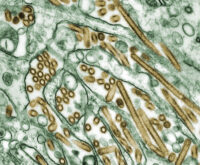 The Highly pathogenic avian influenza (HPAI) A(H5) viruses (also known as Bird Flu or Avian Flu or H5N1) has been detected in U.S. wild aquatic birds (like ducks and shorebirds), commercial poultry and backyard or hobbyist flocks beginning in January 2022. These are the first detections in the U.S. since 2016. Wild birds can be infected even if they don’t look or act sick.
The Highly pathogenic avian influenza (HPAI) A(H5) viruses (also known as Bird Flu or Avian Flu or H5N1) has been detected in U.S. wild aquatic birds (like ducks and shorebirds), commercial poultry and backyard or hobbyist flocks beginning in January 2022. These are the first detections in the U.S. since 2016. Wild birds can be infected even if they don’t look or act sick.
The Center for Disease Control (CDC) considers the current risk to the general public from the H5N1 bird flu outbreak in wild birds and poultry to be low. Avian Flu is not easily transmitted from birds to people. It spreads slowly, but can be fatal. Most transmission is believed to have occurred from people handling infected poultry/poultry products. Flu shots will not protect you from contracting Avian Flu.
PRECAUTIONS
It is generally safe to keep birding, to attract and feed birds in your yard, and to monitor nestboxes. But as always, to avoid contracting any illness from wild birds, The Cornell Laboratory of Ornithology recommends that you:
- Avoid direct contact with wild birds.
- Avoid unprotected contact with domestic birds (poultry) that look sick or have died.
- Do not touch surfaces that may be contaminated with saliva, mucous, or feces from wild or domestic birds, or wear gloves and an N95 mask when cleaning out nestboxes.
- Wash your hands thoroughly after handling bird feeders, bird nests, birdbaths, or water contaminated by bird feces.
- Use disposable gloves or double plastic bags to move a dead bird.
More Information:
- Is it okay to pet nestlings?
- Cleaning nestboxes
- Hanta Virus
- USGS precautions for those who handle birds.
Once a disease has entered the body, all parts which are healthy must fight it: not one alone, but all. Because a disease might mean their common death. Nature knows this; and Nature attacks the disease with whatever help she can muster.
– Paracelsus
